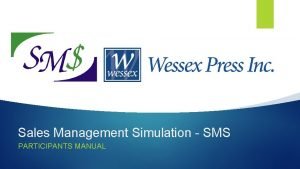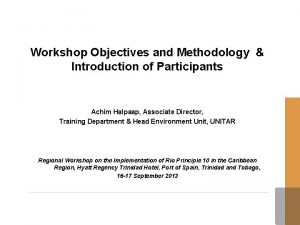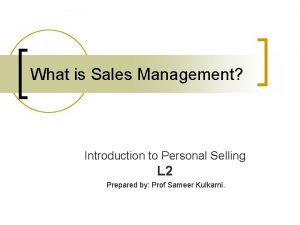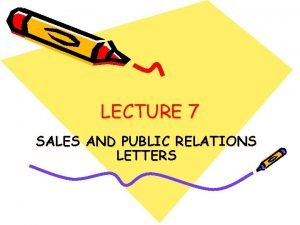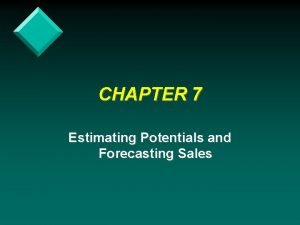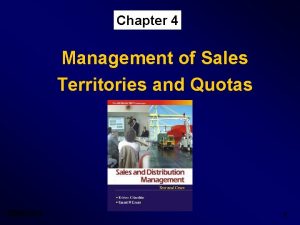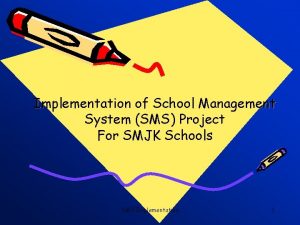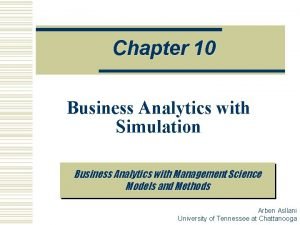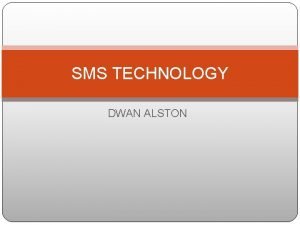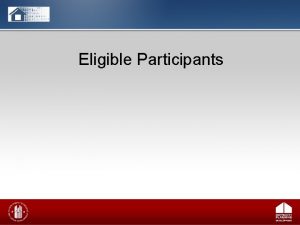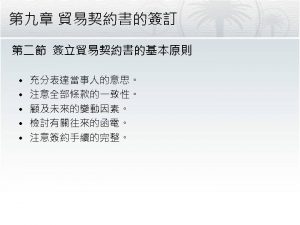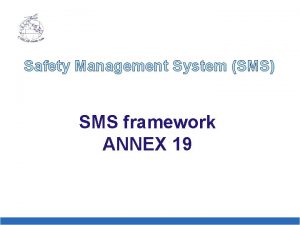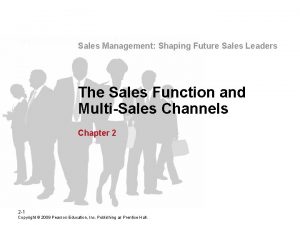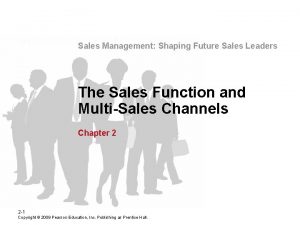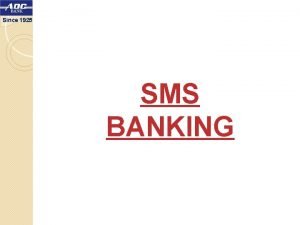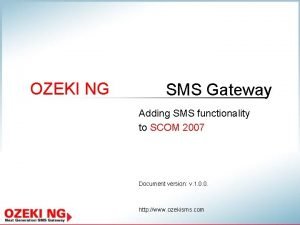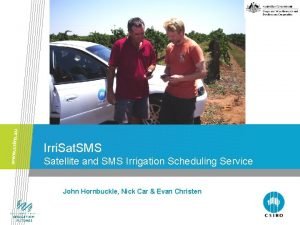Sales Management Simulation SMS PARTICIPANTS MANUAL Introduction The




















- Slides: 20

Sales Management Simulation - SMS PARTICIPANTS MANUAL

Introduction The purpose of the Sales Management Simulation is to help you integrate theory with sales management practices. Your job will be to manage a salesforce and make the sorts of decisions sales managers actually make including - recruiting, selecting, and hiring salespeople assigning salespeople to territories training salespeople compensating salespeople setting time-management policies choosing product prices Your performance will be evaluated using four metrics Profit market share Net Promoter Score (NPS) Company Reputation (CR) In each period, your team will make a series of sales management decisions. In part, the basis for these decisions will be the results from previous period decisions. Additionally, your team will have the ability to purchase market research reports to help you make your decisions SMS is a competitive simulation in the sense that your team competes against other teams in your industry. Your team’s success depends on the quality of your team’s decisions, in the context of market development and competitor teams’ decisions.

Team Roles In each period, your team’s decisions are made by a designated team leader; this role may pass from participant to participant as SMS unfolds period by period. For each period, other team members may make suggestions for the team leader to consider. The team leader may decide to review these suggestions and selectively incorporate all or some of them. Alternatively, the team leader may choose to discuss these suggestions with other team members, and collaboratively arrive at the final decisions. Team Members: each team member submits their own independent suggestions to the team leader Team Leader: takes into consideration all the suggestions but submits the final decisions

Registration and Payment You should receive a registration email with a link that will send you to a payment page Upon payment you should receive a confirmation email Click on “Activate” and set your password Once you set your password, you should receive an email confirming that your account is now active

Sales Management Decisions 1. Hiring new Recruits 2. Retaining Salespeople 3. Assigning Salespeople to Sales Regions 4. Motivating Salespeople 5. Training Salespeople 6. Product Management 7. Market Intelligence 8. Success Indicators 1. Accumulated Income 2. Market Share 3. Net Promoter Score 4. Company Reputation

Hiring new Recruits In each period you have the option to hire up to 5 new salespeople You have access to their resumes, interview score, as well as their graduated school’s median salary You can offer them a higher or lower salary than the schools median depending on their interview scores Each potential recruits has an expectation for total compensation which is salary plus commission Their expectations depend on their university’s median salary and where they rank themselves relative to other graduates As a recruiter you set individual salaries for each salesperson and a commission rate that applies to every salesperson If you see a highly qualified applicant, you should offer a much higher salary than their university’s median.

Retaining Salespeople may decide to resign due to low commission rates, low salary, or poor territory assignment They will warn you when they are considering resignation, and it’s your responsibility to take corrective action Remember that replacing a salesperson costs more than retaining one

Assigning Salespeople to Sales Regions Relocating a salesperson cost $7, 000, but there is no charge for the initial assignment of a newly hired person Salespeople tend to perform better when they are placed in their home region They are happier to be near their homes They are more familiar with the geography, find it easier to build customer relationships You are responsible formulating a region strategy and regularly reevaluating that strategy You can concentrate your team in a few sales regions, spread them around, or pursue other allocation decision

Motivating Salespeople • • Salespeople are motivated by total compensation and placement They will continue to be motivated if total compensation (salary + commission) exceeds total compensation expectations Salary Expectations increases each period, and changes with the average compensation levels of all teams in your class. If other teams continually give their salespeople a raise, your team’s salary expectations will rise Motivating Factors for New Hires • Average earnings of salespeople from their university • Salesperson’s self-rating compared to their peers Motivating Factors for Current Salespeople • • Total compensation compared to their peers within the firm and peers at rival firms in their industry Changing Total Compensation • Individual Salaries • Commission Earnings • Sales Contests

Training Salespeople Onboarding/initial training for new hires is mandatory in the first period they are hired In any period you can decide to provide additional training to individual salespeople Total training expense is $8, 000 per salesperson You must also pay the salesperson their salary plus his/her estimated commission The salesperson will not any sales revenue for the firm in the period they are in training

Product Management Your firm offers two products base product A and premium model B You must make several product management decisions Product emphasis Price of each product You must make demand estimates for each product and make product management decisions for your salespeople to implement Overall market demand for Product A and B varies and evolves over time and changes by region You can influence demand by Changing prices Setting policies between selling to customers and internal selling (selling within the firm) Managing Inventory If your estimates are less than actual demand the factory will produce the actual amount that’s demanded but you will incur extra shift and overtime expenses Additional products required to meet actual demand will cost $40/unit If you overestimate demand, you will carry excess inventory. Inventory carrying expenses are $25/unit Excess inventory will affect your production requirements for the following period

Market Intelligence You can purchase ten market research reports each period to help you make your sales management decisions If you purchase a report in one period, you will receive the report in the following period In the results page in the following period you the market intelligence report you had purchased in the previous quarter will show up on the bottom of you page

Success Indicators Cumulative Profit Each period you receive a profit and loss statement and a balance sheet related to the quality of your decisions The balance sheet tracks cumulative profits every quarter Market Share High market share implies greater customer contact, protects your firm during economic downturns, and helps counter competitive threat Market share is averaged across period Company Reputation (CR) Net Promotor Score (NPS) Company Reputation is related to salespeople’s satisfaction with their employer NPS = 100 => average score across all firms CR = 100 => Industry average NPS > 100 => performance is better than average CR < 100 => performance is less than average Key Factors Average Total Compensation earned by salespeople relative to other firms in the industry Truly satisfied customers will recommend your product to others. Customer satisfaction drives customer loyalty, even when competitive offerings improve or when the economy turns sour NPS < 100 => performance is less than average Factors that drive NPS Lower prices Highly skilled sale people Proportion of salesperson earnings from salary (higher Salespeople accessibility (# of salespeople in a region and Proportion of salesperson’s time spent on internal Company reputation salary => higher reputation score) selling number of regions covered)

Once you submitted your decisions the results report can be found by clicking on the tab “Results” on the left-hand side.

Submitting Decisions • On the “Home” tab click on “Make Decision” • It will direct you to the second image, where you will make all your sales management decisions • Once you click “Submit” on the bottom of the page your status will be updated to “Your decision has been submitted!” • If you would like to change your decisions click “Edit Decision” and you will be redirected back to the second page.

Case Studies

Profit 2, 000 1, 500, 000 1, 000 500, 000 0 Quarter 1 Quarter 2 Quarter 3 Quarter 4 -500, 000 Team 1 Team 2 Q 1: Compensation Team 1: increases total compensation for all employees Team 2: compensation is kept constant Q 2: Compensation & Prices Team 1: increases total compensation and prices Team 2: decreases prices Q 1: An increase in compensation has a positive effect on profits Q 2: An increase in compensation and prices has a large and positive effect on profits and a decrease in prices results in negative profits Team 1: increases internal selling Q 3: Increasing internal selling has a negative effect on profits Q 4: Increases in commission and salary has similar effects on profit Team 2: internal selling is kept constant Conclusion: Prices has the biggest effect on profit levels Q 3: Internal Selling Q 4: Differences in Strategy Team 1: raises salaries Team 2: raises commission

Market Share 60. 00% 50. 00% 40. 00% 30. 00% 20. 00% Q 1: Compensation Team 1: increases total compensation for all employees Team 2: compensation is kept constant 10. 00% Quarter 1 Quarter 2 Team 1 Quarter 3 Quarter 4 Q 2: Compensation & Prices Team 1: increases total compensation and prices Team 2: decreases prices Team 2 Q 1: Increasing compensation has a positive effect on market share Q 2: An increase in prices and compensation results in a higher market share than a decrease in prices, but the differences is smaller than Q 1 with Team 2 increasing market share in Q 2 and Team 1 decreasing market share in Q 2. Price has a negative correlation with market share. Q 3: Increasing internal selling has a negative effect on market share Q 4: Increases in salary and commission has similar effects on market share Conclusion: Compensation has the highest positive effect on market share and internal selling has the highest negative effect on market share Q 3: Internal Selling Team 1: increases internal selling Team 2: internal selling is kept constant Q 4: Differences in Strategy Team 1: raises salaries Team 2: raises commission

Employee Satisfaction (Reputation) 110 105 100 Q 1: Compensation Team 1: increases total compensation for all employees Team 2: compensation is kept constant 95 90 85 80 Quarter 1 Quarter 2 Team 1 Quarter 3 Quarter 4 Team 1: increases total compensation and prices Team 2: decreases prices Team 2 Q 1: Increasing compensation has a positive effect on employee satisfaction Q 2: Increasing salary and prices raises employee satisfaction and decreasing prices lowers employee satisfaction Q 3: Increasing internal selling has a positive effect on employee satisfaction Q 4: Raising salary has a greater effect on employee satisfaction than raising commission Q 2: Compensation & Prices Conclusion: Internal selling has the biggest effect on employee satisfaction Q 3: Internal Selling Team 1: increases internal selling Team 2: internal selling is kept constant Q 4: Differences in Strategy Team 1: raises salaries Team 2: raises commission

Net Promoter Score (NPS) 103 102 101 100 Q 1: Compensation Team 1: increases total compensation for all employees Team 2: compensation is kept constant 99 98 97 96 Quarter 1 Quarter 2 Team 1 Quarter 3 Quarter 4 Team 1: increases total compensation and prices Team 2: decreases prices Team 2 Q 1: Increasing compensation has a positive effect on NPS Q 2: Increases in salary and prices and decreases in prices result in similar NPS, but Team 2 NPS increases in Q 2 suggesting that prices has a negative correlation with NPS Q 3: Increasing internal selling has a positive effect on NPS Q 4: An increase in salaries has a greater effect on NPS than an increase in commission Q 2: Compensation & Prices Conclusion: Internal selling has the biggest effect on NPS Q 3: Internal Selling Team 1: increases internal selling Team 2: internal selling is kept constant Q 4: Differences in Strategy Team 1: raises salaries Team 2: raises commission
 Bramka sms api
Bramka sms api Sms based poll monitoring system
Sms based poll monitoring system Wessex sales management simulation
Wessex sales management simulation Introduction of participants in a workshop
Introduction of participants in a workshop Introduction of participants in a workshop
Introduction of participants in a workshop Dump truck problem in simulation
Dump truck problem in simulation Sales management introduction
Sales management introduction Introduction to sales management
Introduction to sales management In the twenty-first century, sales leaders are
In the twenty-first century, sales leaders are Sales organizational structure
Sales organizational structure Discuss the nuances of sales letters.
Discuss the nuances of sales letters. Sales force composite
Sales force composite Sales organization structure and sales force deployment
Sales organization structure and sales force deployment Sales territories and quotas
Sales territories and quotas School sms system
School sms system Phoenix life cycle
Phoenix life cycle Sms safety management system
Sms safety management system Tahapan sales proses
Tahapan sales proses Introduction to modeling and simulation
Introduction to modeling and simulation Introduction to modeling and simulation
Introduction to modeling and simulation Introduction to business analytics using simulation
Introduction to business analytics using simulation


